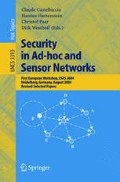Abstract
The common perception of public key cryptography is that it is complex, slow and power hungry, and as such not at all suitable for use in ultra-low power environments like wireless sensor networks. It is therefore common practice to emulate the asymmetry of traditional public key based cryptographic services through a set of protocols [1] using symmetric key based message authentication codes (MACs). Although the low computational complexity of MACs is advantageous, the protocol layer requires time synchronization between devices on the network and a significant amount of overhead for communication and temporary storage. The requirement for a general purpose CPU to implement these protocols as well as their complexity makes them prone to vulnerabilities and practically eliminates all the advantages of using symmetric key techniques in the first place. In this paper we challenge the basic assumptions about public key cryptography in sensor networks which are based on a traditional software based approach. We propose a custom hardware assisted approach for which we claim that it makes public key cryptography feasible in such environments, provided we use the right selection of algorithms and associated parameters, careful optimization, and low-power design techniques. In order to validate our claim we present proof of concept implementations of two different algorithms—Rabin’s Scheme and NtruEncrypt—and analyze their architecture and performance according to various established metrics like power consumption, area, delay, throughput, level of security and energy per bit. Our implementation of NtruEncrypt in ASIC standard cell logic uses no more than 3,000 gates with an average power consumption of less than 20 μW. We envision that our public key core would be embedded into a light-weight sensor node architecture.
This material is based upon work supported by the National Science Foundation under Grants No. ANI-0133297 (NSF CAREER Award) and No. ANI-0112889.
Access this chapter
Tax calculation will be finalised at checkout
Purchases are for personal use only
Preview
Unable to display preview. Download preview PDF.
References
Perrig, A., Szewczyk, R., Tygar, J.D., Wen, V., Culler, D.E.: SPINS: security protocols for sensor networks. Wireless Networks 8, 521–534 (2002)
Fulford, B.: Sensors gone wild. Forbes Global (2002), http://www.forbes.com/global/2002/1028/076_print.html
Polastre, J.: Design and implementation of wireless sensor networks for habitat monitoring. Master’s thesis, University of California at Berkeley (2003)
Mainwaring, A., Polastre, J., Szewczyk, R., Culler, D., Anderson, J.: Wireless sensor networks for habitat monitoring. In: First ACM Workshop on Wireless Sensor Networks and Applications, Atlanta, GA, USA (2002)
Burne, R., et al.: Self-organizing cooperative sensor network for remote surveillance: improved target tracking results. In: Proceedings of the SPIE, Boston. SPIE, vol. 4232, pp. 313–321. SPIE-Int. Soc. Opt. Eng., USA (2001)
Meininger, S., Mur-Miranda, J., Amirtharajah, R., Chandrakasan, A., Lang, J.: Vibration-to-electric energy conversion. IEEE Transactions on Very Large Scale Integration (VLSI) Systems 9, 64–76 (2001)
Amirtharajah, R., Chandrakasan, A.P.: Self-powered signal processing using vibration-based power generation. IEEE Journal of Solid-State Circuits 33, 687–695 (1998)
Carman, D.W., Kruus, P.S., Matt, B.J.: Constraints and approaches for distributed sensor network security. Technical report, NAI Labs, Security Research Division, Glenwood, MD (2000)
Weimerskirch, A., Paar, C., Shantz, S.C.: Elliptic curve cryptography on a Palm OS device. In: Varadharajan, V., Mu, Y. (eds.) ACISP 2001. LNCS, vol. 2119, pp. 502–513. Springer, Heidelberg (2001)
Rabin, M.O.: Digitalized signatures and public key functions as intractable as factorization. Mit/lcs/tr-212, Massachusetts Institute of Technology (1979)
Rivest, R.L., Shamir, A., Adleman, L.: A method for obtaining digital signatures and public-key cryptosystems. Commun. ACM 21, 120–126 (1978)
Hoffstein, J., Pipher, J., Silverman, J.: NTRU: A ring-based public key cryptosystem. In: Buhler, J.P. (ed.) ANTS 1998. LNCS, vol. 1423, pp. 267–288. Springer, Heidelberg (1998)
Lenstra, A.K., Verheul, E.R.: Selecting cryptographic key sizes. Journal of Cryptology: The Journal of the International Association for Cryptologic Research 14, 255–293 (2001)
Hoffstein, J., Silverman, J., Whyte, W.: NTRU report 012, version 2. estimated breaking times for NTRU lattices. Technical Report 12, NTRU Cryptosystems, Inc., Burlington, MA, USA (2003)
Menezes, A.J., van Oorschot, P.C., Vanstone, S.: Handbook of Applied Cryptography. CRC Press Inc., Boca Raton (1997)
Hoffstein, J., Silverman, J.H.: Optimizations for NTRU. In: Proceedings of Public Key Cryptography and Computational Number Theory, de Gruyter, Warsaw (2000)
Bailey, D., Coffin, D., Elbirt, A., Silverman, J., Woodbury, A.: NTRU in constrained devices. In: Koç, Ç.K., Naccache, D., Paar, C. (eds.) CHES 2001. LNCS, vol. 2162, pp. 266–277. Springer, Heidelberg (2001)
Devadas, S., Malik, S.: A survey of optimization techniques targeting low power VLSI circuits. In: Proceedings of the 32nd ACM/IEEE Conference on Design Automation, pp. 242–247 (1995)
Rabaey, J., Pedram, M.: Low Power Design Methodologies. Kluwer Academic Publishers, Norwell (1996)
Parhami, B.: Computer Arithmetic: Algorithms and Hardware Designs. Oxford University Press, Oxford (2000)
Epstein, M., Hars, L., Krasinski, R., Rosner, M., Zheng, H.: Design and implementation of a true random number generator based on digital circuit artifacts. In: Walter, C.D., Koç, Ç.K., Paar, C. (eds.) CHES 2003. LNCS, vol. 2779, pp. 152–165. Springer, Heidelberg (2003)
Author information
Authors and Affiliations
Editor information
Editors and Affiliations
Rights and permissions
Copyright information
© 2005 Springer-Verlag Berlin Heidelberg
About this paper
Cite this paper
Gaubatz, G., Kaps, JP., Sunar, B. (2005). Public Key Cryptography in Sensor Networks—Revisited. In: Castelluccia, C., Hartenstein, H., Paar, C., Westhoff, D. (eds) Security in Ad-hoc and Sensor Networks. ESAS 2004. Lecture Notes in Computer Science, vol 3313. Springer, Berlin, Heidelberg. https://doi.org/10.1007/978-3-540-30496-8_2
Download citation
DOI: https://doi.org/10.1007/978-3-540-30496-8_2
Publisher Name: Springer, Berlin, Heidelberg
Print ISBN: 978-3-540-24396-0
Online ISBN: 978-3-540-30496-8
eBook Packages: Computer ScienceComputer Science (R0)

